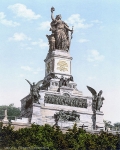Niederwalddenkmal Monument
Archaeology »
Archaeological Monuments » Niederwalddenkmal Monument
Niederwalddenkmal Monument -
Niederwalddenkmal Monument is located in Rudesheim am Rhein,Hesse.
Niederwalddenkmal Monument monument was established on 1871.
Primary threats to Niederwalddenkmal Monument :
The central figure is the 10.5 meter tall Germania figure. In the sculpture impression Germania holds in the right hand the recovered crown of the emperor and in the left the imperial sword.
Historical facts of Niederwalddenkmal Monument :
- The Niederwalddenkmal Monument, situated in the Rheingau region of Germany, is a historically significant landmark that represents the unity and pride of the German nation. Construction of the monument began in 1871 and was completed in 1883, commissioned to commemorate the foundation of the German Empire and to honor the victories achieved during the Franco-Prussian War.
- The architect behind the Niederwalddenkmal Monument was Johannes Schilling, a renowned German architect of the time. The monument itself is a grand structure consisting of a central statue and various sculptures and reliefs that depict important historical events and figures. At the heart of the monument stands Germania, a female embodiment of the nation, adorned with an oak leaf crown, wielding a sword and a crown, symbolizing the strength and unity of the German people.
- Adjacent to Germania, several allegorical sculptures represent virtues such as courage, loyalty, and patriotism. These sculptures were created by notable artists including Karl Tornow, Gustav Eberlein, and Ludwig Brunow. Additionally, there are relief panels that depict significant moments from German history, such as scenes from the Franco-Prussian War and the signing of the German unification treaty.
- The Niederwalddenkmal Monument not only pays homage to the past but also serves as a beacon of hope for the future. It stands as a reminder of the significance of unity and national identity, as well as the sacrifices made by the German people to achieve their objectives. The monument holds a profound historical and cultural significance, attracting visitors from around the globe who come to appreciate its beauty, historical relevance, and panoramic views of the surrounding region.
- Throughout its existence, the Niederwalddenkmal Monument has witnessed various significant historical events. During World War II, the monument suffered damages due to bombings, but it was subsequently restored to its former splendor. Over the years, the site has become a popular venue for political rallies and gatherings, serving as a backdrop for speeches by German leaders and symbolizing national pride.
- Presently, the Niederwalddenkmal Monument is a protected cultural heritage site and a major tourist attraction in Germany. Visitors can climb the 200 steps leading to the platform of the monument and indulge in breathtaking views of the Rhine Valley. The surrounding area offers picturesque walking trails, vineyards, and the nearby Niederwald Forest, making it a sought-after destination for both nature enthusiasts and history buffs.
- In conclusion, the Niederwalddenkmal Monument stands as a testament to German unity and the triumphs of the past. Its magnificent architecture, sculptures, and reliefs commemorate the founding of the German Empire and the victories achieved during the Franco-Prussian War. The monument symbolizes national pride and serves as a reminder of the importance of unity and perseverance. Today, it continues to captivate visitors with its historical significance, scenic location, and its role as a cherished landmark in German history.

